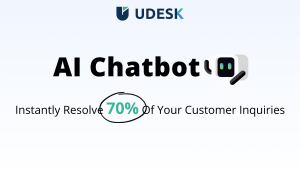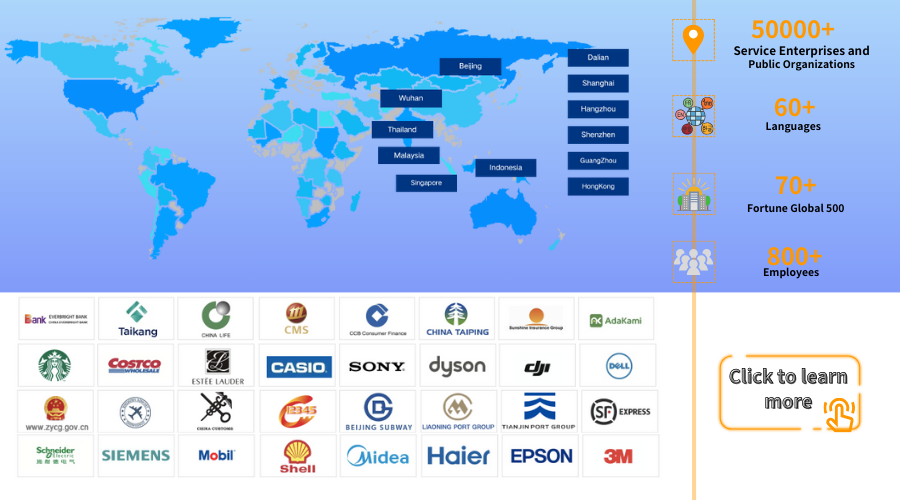Exploring the Customer Service Industry
Article Summary:In our daily lives, we've become accustomed to the omnipresence of intelligent customer service – be it on online shopping platforms, post-purchase inquiries, or self-service guidance. This article delves into the characteristics of the customer service industry, providing an in-depth analysis that sheds light on the powerful functionalities of AI within this domain.
Table of contents for this article
- Introduction to the Customer Service
- The Characteristics of the Customer Service Industry
- Customer Service Operations can be Deconstructed into Several Key Segments
- The Practical Application of AI in the Customer Service
- Get started with Udesk’s system for free
- 》》Click to start your free trial of AI chatbot, and experience the advantages firsthand.
In our daily lives, we've become accustomed to the omnipresence of intelligent customer service – be it on online shopping platforms, post-purchase inquiries, or self-service guidance. This article delves into the characteristics of the customer service industry, providing an in-depth analysis that sheds light on the powerful functionalities of AI within this domain.
Introduction to the Customer Service

Before delving into how AI is empowering the customer service industry, let's first dissect the sector. Customer service is broadly divided into two key components: pre-sales customer service and after-sales customer service.
Pre-Sales Customer Service: Pre-sales customer service refers to the support and assistance rendered to customers prior to their purchase of a product or service. This encompasses answering inquiries about products or services, providing information on features, explaining pricing and payment options, and guiding customers towards informed purchasing decisions. Pre-sales customer service is designed to enhance the customer's experience, drive sales, and build customer trust and satisfaction with the brand.
After-sales customer service: After-sales customer service refers to the professional service personnel or service team set up by an enterprise to solve the various problems encountered by consumers in the process of using the goods or enjoying the services after the completion of the sale of goods. Their main responsibilities include:
Query Resolution: Offering guidance on product usage, addressing client questions related to functionality, maintenance, and more.
Technical Support: For technical products, after-sales service agents must possess adequate technical knowledge to troubleshoot problems customers encounter during usage.
Complaint Handling: Receiving and addressing customer dissatisfaction and complaints, implementing remedies to restore customer contentment.
Return & Exchange Services: Administering return or exchange requests per company policy, coordinating logistics to ensure a smooth process.
Repair Services: Facilitating product repairs or replacements, occasionally including the coordination of on-site services or returns for workshop repairs.
Customer Feedback Collection: Gathering feedback from clients regarding goods and services, which is then utilized for product enhancement and process optimization.
The Characteristics of the Customer Service Industry

The customer service industry is characterized by several distinctive traits:
- High Maintenance Costs: Customer service predominantly operates in a "reactive" mode, necessitating a substantial workforce to address a myriad of user inquiries, complaints, and feedback, thereby entailing significant human resource investments.
- Limited Value Creation: The pre-sales customer service segment engages a multitude of non-paying users, making it challenging to generate direct revenue from servicing these individuals.
Consequently, for businesses, customer service represents a high-cost, low-return endeavor, often categorized as a cost center. The ultimate ambition within the AI realm, therefore, becomes reducing human labor in customer service operations, aspiring even toward a fully automated, human-free customer service experience.
Customer Service Operations can be Deconstructed into Several Key Segments
- Customer Service Training
Customer service training is a systematic process aimed at enhancing the capabilities, professional competence, and communication skills of service representatives through a blend of specialized instruction and practical exercises. This ensures they can effectively and professionally address customer concerns, thereby elevating satisfaction levels. Key components include product knowledge workshops, operational protocol training, honing communication tactics, and fostering problem-solving abilities alongside teamwork ethics. Efficient managers must adapt to evolving business dynamics, allocating resources wisely and delivering targeted training to cater to new challenges.
- User Engagement
The user service phase can be further dissected into distinct steps: "Issue Identification," "Resolution," "Follow-up," "Feedback Collection," and "Documentation & Reporting." Service agents are tasked with addressing customer queries, extracting valuable insights from these interactions, and internally reporting and summarizing them.
As the frontline department interfacing directly with users, the customer service team plays a crucial role in integrating and analyzing feedback, channeling this information to operations, sales, and even supply chain departments. Maximizing its value lies in effectively leveraging this contact to inform broader organizational strategies.
- Customer Service Management
Given that customer service personnel are human, instances of negative attitude or complacency may arise. Implementing mechanisms to closely monitor agent behavior and assess performance is therefore vital. Utilizing data analytics, real-time monitoring, and a suite of performance indicators enables a granular measurement of work quality, facilitating more effective management practices. This approach not only maintains service standards but also fosters a culture of continuous improvement within the customer service team.
The Practical Application of AI in the Customer Service
AI Chatbot is a good example.

Multi-turn Dialogues
When customers approach customer service, they typically have a specific objective in mind. While some inquiries can be resolved with a single response, others such as return and refund processes or complaints necessitate more. Moreover, clients often struggle to articulate their issues succinctly, leading to the use of synonyms, incomplete sentences, among other challenges. In these scenarios, multiple rounds of questioning and answering become imperative. Consequently, the corpus for Chatbot’s intelligent Q&A systems isn't limited to single-sentence inputs; it can also encompass multi-sentence constructs, thereby broadening the scope of scenarios the system can handle.
Multimodal Responses
Multimodal responses extend beyond typical media like images, voice messages, or videos to incorporate elements like links, forms, and questionnaires. This enriches the interaction with users, enhancing the density of information exchanged and expediting problem resolution.
Diversified Knowledge Bases
Not all issues can be satisfactorily addressed through straightforward answers. Therefore, in addition to addressing technical queries, smart customer service must also be capable of small talk, casual conversation, and providing reassurance to better serve clients. Tailored corpora in Chatbot are thus required to adapt to varying contexts, with keyword recognition and intent analysis functionalities employed to dictate which knowledge base to draw from in a given scenario.
Get started with Udesk’s system for free
An increasing number of enterprises are adopting intelligent customer service systems to enhance the efficiency of their support operations. Udesk, with its wealth of experience in the realm of smart customer service and a track record of successful collaborations accompanied by widespread acclaim, offers solutions—be its chatbots or other products—that elevate customer service standards to unprecedented heights.
》》Click to start your free trial of AI chatbot, and experience the advantages firsthand.
The article is original by Udesk, and when reprinted, the source must be indicated:https://www.udeskglobal.com/blog/exploring-the-customer-service-industry.html
AI ApplicationAI chatbotCustomer Service Industry

 Customer Service& Support Blog
Customer Service& Support Blog



